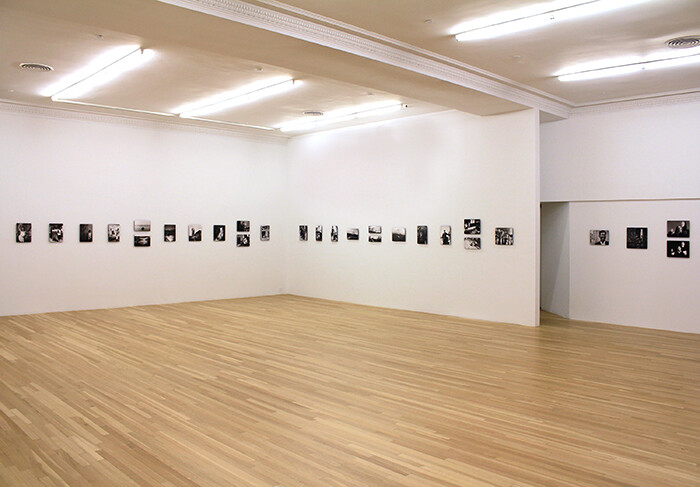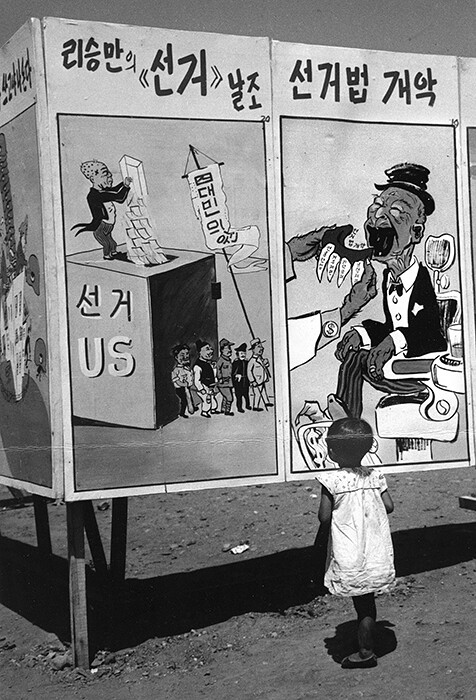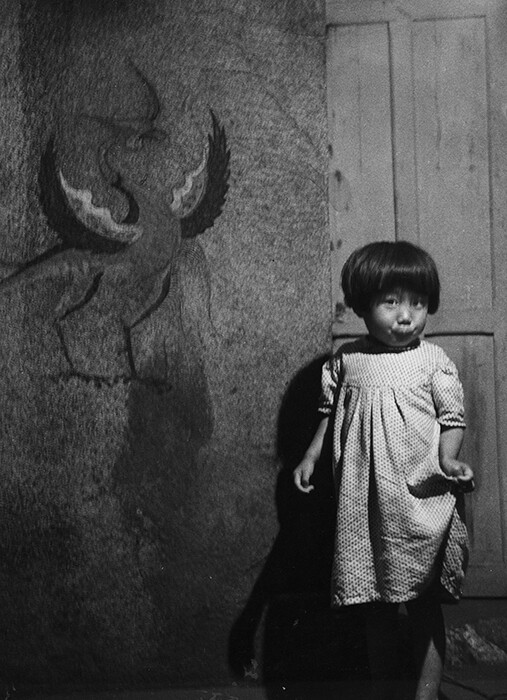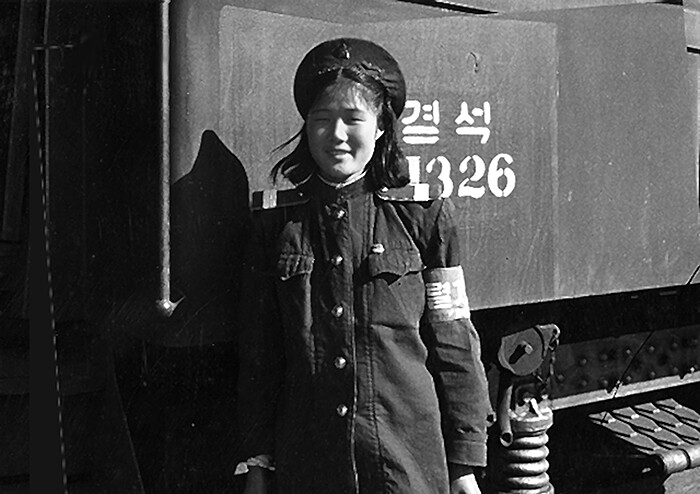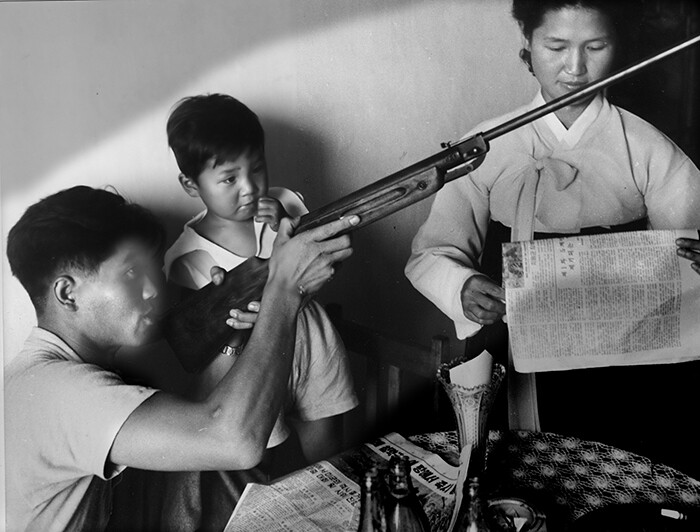A sequence of photos by Chris Marker on display at New York’s Peter Blum Gallery features a little girl. The 51 images are mostly snapshots; matte, legal-pad-sized prints hung evenly at eye level around the four walls of the gallery. Some appear to have a kind of incidental chronology, following a single figure through different settings, as with the child in a dress. In one image, we are positioned behind her as she faces a propaganda poster. In another, we see her alone amidst a vast public plaza. In a third, she regards us quizzically alongside a strange painting on a stone wall. In each case we feel as if we are alongside the girl, sharing her field of vision and experience, rather than regarding her as a subject for pity or contemplation. The photos were taken in 1957 when “the formidable propaganda machine that would soon be identified with the sheer mention of North Korea wasn’t yet running at full throttle,” as Marker puts it in an accompanying testimony. The resulting photos, he notes with amusement, were rejected on both sides of the 38th parallel:
“To the North, [work] which never mentioned once the name of Kim Il-sung simply didn’t exist. To the South, the raw fact that it had been allowed to be done in North Korea made it a tool of communist propaganda. That’s how, I was told, it was exhibited in Seoul’s counter-revolutionary museum, and its author introduced as a ‘Marxist dog’. I didn’t mind. Since Snoopy, the word ‘dog’ has ceased to be an insult in my cats-ruled world.”1
Happily identifying with dogs, cats, and children: this is pure Marker, someone who, for all his intellectual power and political commitment, never slipped into facile didacticism or formal austerity. When his work was long or difficult—as it often was—it was because his subjects were long and difficult, and not because he felt that length or difficulty were castor-oil and vitamins for his audience, unpleasant but necessary, in and of themselves, for the viewers’ long-term health and well-being. If Godard was the first-born cinematic child of Brecht’s theory of the distancing effect, then Marker was his other, second son, and, perhaps, the one who followed his precursor’s practice most closely.
Brecht’s theory of the Verfremdungseffekt—which he borrowed from the Russian formalists—held that the audience’s identification with the characters on stage must be disrupted. Entering the theater as more or less willing pawns of the ruling class, the spectators, via the pedagogy of the distancing effect, leave as critical thinkers. The viewer’s initial position is taken to be one of unconscious, maleficent separation from their true interests and, by being alienated again, this time from the conventions of narrative storytelling, they come to recognize their own interpolation as national subjects to be so much hocus-pocus. Montage, gesture, and direct address are thus difficult to swallow for an audience accustomed to the Wagnerian Gesamtkunstwerk, or total work of art, and this difficulty is necessary to stimulate the aggregate demand for revolution.
This could be called the “revelation” school of Brechtian representation, in that the intention is to shock the audience out of their false consciousness and into the revelation of the real conditions of their lives. But this is one thing in mechanically reproducible genres, like film and photography, and another, perhaps, in the theater, where the encounter with the work is always fixed in time and space. More to the point, the revelation school emphasizes Brecht’s theory as opposed to his practice, which, in plays like Roundheads and Peakheads (1936), The Private Life of the Master Race (1938), and The Resistible Rise of Arturo Uri (1941), is closer, in some ways, to Marker than it is to Godard. Here the audience is not cast as thought-less drones in need of critical shock therapy, but, on the contrary, as thought-full spectators hungry for information. The problem is less the audience’s identification with the characters on stage or in film than it is with the sorts of circumstances it is encouraged to identify with. This is particularly clear when the background is North Korea, whose casting as the locus classicus of unfreedom in the American political imaginary would emphasize the absolute difference between the two territories and their alienation one from the other. It is this distance that Marker’s photographs collapse. His subjects, with their immense variety of activities—shooting guns, making things, dancing ballet, performing traditional rituals—are like Brecht’s protagonists, neither angels nor demons, but individuals negotiating a social landscape littered with contradictions. The effect is to drive a wedge not between audience and performer, but between all of us humans, on the one hand, and the instituted narratives that would divide us—by reference to our ostensible freedom, our race, or our nationality—on the other. Marker’s subjects are not alienated from us so much as they are alienated like us. Hence the emphasis on Marker’s camera placement alongside the figure of the girl—rather than above or below—as we confront the grimacing propaganda image together, side by side, as a kind of montage or jump-cut already embedded in the lifeworld.
Marker thus exemplifies a second Brechtian tendency, the realist school, wherein representation seeks to accompany the audience, to address them as comrades and adults, not, as with revelation, in order to scramble their thinking, but to contribute to its already ongoing and essential process. The difficulty with the realist school is that it requires a great deal of faith; faith in the possibility of communication, faith in the strength and vitality of the larger movement, and, above all, faith in the people as partisans of their own individual and collective autonomy. Whether such thinking is possible today, I cannot say, but what is certain is that it shines, joyous and indomitable, throughout Chris Marker’s “Koreans.”
Chris Marker, 2009, quoted at peterblumgallery.com, last accessed October 7, 2014: http://peterblumgallery.com/exhibitions/2014/chris-marker-koreans/press-release.
